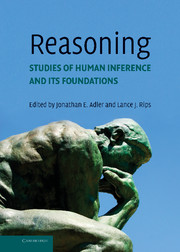Book contents
- Frontmatter
- Contents
- Preface
- List of Contributors
- Introduction: Philosophical Foundations
- PART I FOUNDATIONS OF REASONING
- PART II MODES OF REASONING
- PART II INTERACTIONS OF REASONING IN HUMAN THOUGHT
- Section 9 Reasoning and Pragmatics
- Section 10 Domain-Specific, Goal-Based, and Evolutionary Approaches
- 39 Domain-Specific Knowledge and Conceptual Change
- 40 Pragmatic Reasoning Schemas
- 41 Beyond Intuition and Instinct Blindness: Toward an Evolutionarily Rigorous Cognitive Science
- 42 Use or Misuse of the Selection Task? Rejoinder to Fiddick, Cosmides, and Tooby
- 43 Why We Are So Good at Catching Cheaters
- 44 The Modularity of Mind: An Essay on Faculty Psychology
- 45 Commitment
- 46 Evolution of Inference
- Section 11 Reasoning and Cultures
- Section 12 Biology, Emotions, and Reasoning
- Index
- References
39 - Domain-Specific Knowledge and Conceptual Change
Published online by Cambridge University Press: 05 June 2012
- Frontmatter
- Contents
- Preface
- List of Contributors
- Introduction: Philosophical Foundations
- PART I FOUNDATIONS OF REASONING
- PART II MODES OF REASONING
- PART II INTERACTIONS OF REASONING IN HUMAN THOUGHT
- Section 9 Reasoning and Pragmatics
- Section 10 Domain-Specific, Goal-Based, and Evolutionary Approaches
- 39 Domain-Specific Knowledge and Conceptual Change
- 40 Pragmatic Reasoning Schemas
- 41 Beyond Intuition and Instinct Blindness: Toward an Evolutionarily Rigorous Cognitive Science
- 42 Use or Misuse of the Selection Task? Rejoinder to Fiddick, Cosmides, and Tooby
- 43 Why We Are So Good at Catching Cheaters
- 44 The Modularity of Mind: An Essay on Faculty Psychology
- 45 Commitment
- 46 Evolution of Inference
- Section 11 Reasoning and Cultures
- Section 12 Biology, Emotions, and Reasoning
- Index
- References
Summary
Overview
We argue that human reasoning is guided by a collection of innate domain-specific systems of knowledge. Each system is characterized by a set of core principles that define the entities covered by the domain and support reasoning about those entities. Learning, on this view, consists of an enrichment of the core principles, plus their entrenchment, along with the entrenchment of the ontology they determine. In these domains, then, we would expect cross-cultural universality: cognitive universals akin to language universals.
However, there is one crucial disanalogy to language. The history of science and mathematics demonstrates that conceptual change in cognitive domains is both possible and actual. Conceptual change involves overriding core principles, creating new principles, and creating new ontological types. We sketch one potential mechanism underlying conceptual change and motivate a central empirical problem for cognitive anthropology: To what extent is there cross-cultural universality in the domains covered by innate systems of knowledge?
Domain-Specific Cognition
The notion of domain-specific cognition to be pursued here is articulated most clearly by Chomsky (1980a). Humans are endowed with domain-specific systems of knowledge such as knowledge of language, knowledge of physical objects, and knowledge of number. Each system of knowledge applies to a distinct set of entities and phenomena. For example, knowledge of language applies to sentences and their constituents; knowledge of physical objects applies to macroscopic material bodies and their behavior; knowledge of number applies to sets and to mathematical operations such as addition.
- Type
- Chapter
- Information
- ReasoningStudies of Human Inference and its Foundations, pp. 807 - 826Publisher: Cambridge University PressPrint publication year: 2008
References
- 2
- Cited by



